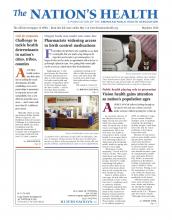Audrey Novak believes looking through an eye may be the only way a doctor can look inside someone without opening her or him up.
As executive director of the Maryland Society for Sight, Novak has seen first-hand how often adults, some of whom rely on free vision screenings from her organization, fail to see how their eye health is connected to their overall health. It is an issue that is now affecting millions of Americans and prompting public health to spring into action to save sight.
“Education is really important,” Novak told The Nation’s Health. “We could stand there and hand out pamphlets and proselytize people, but there’s really something that grabs a person when they do an activity that shows them they’re not seeing the way they should be seeing.”
About 4 million Americans ages 40 and older are either blind or have vision loss due to conditions such as cataracts, diabetic retinopathy and glaucoma, according to a May 2015 study in the Centers for Disease Control and Prevention’s Morbidity and Mortality Weekly Report. That number could jump to 10 million people by 2050. In addition to regular eye exams, lifestyle changes, such as quitting smoking and keeping a healthy weight, could help lower the risk for vision problems in the future, researchers said.
Because of risk factors such as poor health, smoking and poor nutrition, vision loss should be placed within the context of chronic health issues such as obesity, and eye care should become a part of comprehensive health care, said Janis Winters, OD, FAAO, an associate professor at the Illinois College of Optometry and chair of APHA’s Vision Care Section. Failing to see the importance of vision care could rob Americans of their ability to live independently in the future.

A woman receives an eye exam during a Remote Area Medical clinic health event in April 2010 in Los Angeles. About 4 million Americans ages 40 and older are either blind or have vision loss from conditions such as cataracts or glaucoma.
Photo by David McNew, courtesy Getty Images
“Obesity-related conditions, such as heart disease, stroke and diabetes, are among the leading causes of preventable death in the U.S.,” Winters told The Nation’s Health. “Although most providers easily recognize the correlation between obesity and systemic obesity-related conditions, many do not realize that obesity is shown to positively correlate with the leading causes of preventable blindness: diabetic retinopathy, glaucoma, macular degeneration and cataracts. All of these needless sight-stealing conditions have a positive correlation with increasing BMI, a relationship that must be addressed.”
The severity of the issue has not been lost on U.S. public health officials. Healthy People 2020, a federal roadmap of benchmarks to improve population health, lists eight objectives focused on vision health, including one on reducing visual impairment that aims to lower instances of vision issues related to glaucoma, cataracts and diabetic retinopathy. For example, in 2008, 13.9 people per 1,000 population ages 45 and older had glaucoma-related vision issues. The goal is to reduce that to 12.5 people per 1,000 people by 2020.
But there are barriers. Some people may lack access to eye health providers because their insurance does not cover vision care. According to CDC, the cost of vision problems in 2013 in the U.S. was about $145 billion. There is also a lack of understanding about how eye diseases progress, said Dean VanNasdale, OD, PhD, an assistant professor at Ohio State University’s College of Optometry and secretary of APHA’s Vision Care Section.
“It is important for the public to have a better understanding that age-related eye diseases can develop without symptoms,” VanNasdale told The Nation’s Health. “Patients may not know that they have developed pathological changes associated with these sight-threatening diseases until irreversible damage has already occurred.”
Another barrier is the lack of communication across different medical disciplines. VanNasdale said that optometrists must think about how what they do is interconnected with other health practitioners.
“Eye care practitioners need to think of ways to better coordinate care across a diverse range of health disciplines,” VanNasdale said. “It’s not only a need to educate patients, but other health care practitioners as well, making sure they understand the complex network of care necessary to effectively manage older patients with chronic conditions that have vision implications.”
Recognizing the need to inform patients and health care providers about vision and health, the CDC in 2005 launched the Vision Health Initiative, an ongoing project that has brought vision care experts together from across the U.S. to publish research on vision loss and create evidence-based interventions.
The initiative’s main goals are to monitor the burden, evaluate and implement evidence-based interventions that translate the science into practice and develop programs and inform decision makers.
Since the start of the initiative, questions about vision loss and eye diseases have been added to CDC’s Behavioral Risk Factor Surveillance System to determine how many Americans have potential vision issues.
The initiative was a lead sponsor, in collaboration with other federal agencies and private sector organizations, of an upcoming report, “Public Health Approaches to Reduce Vision Impairment and Promote Eye Health.” The report, which will be released by the Health and Medicine Division of the National Academies of Sciences, Engineering and Medicine, will provide recommendations to improve the nation’s vision and eye health.
“Three-quarters of the vision loss in the U.S. could be prevented by what we know now: fitting glasses, preventing diabetes, cataract surgery and others,” Jinan Saaddine MD, MPH, team lead of the Vision Health Initiative, told The Nation’s Health. “We have many public health interventions that can curb this problem. They’re cost effective.”

An optometrist performs an eye exam during a Remote Area Medical clinic event held in April 2011 in Oakland, California. In 2008, 13.9 people per 1,000 population ages 45 and older had glaucoma-related vision issues in the United States.
Photo by Justin Sullivan, courtesy Getty Images
Grassroots approach targets vision health
While the Vision Health Initiative has made inroads on assessment and surveillance, it also plays a role in developing and implementing public health interventions. In Philadelphia, the initiative has funded outreach programs via Wills Eye Hospital to detect glaucoma in high-risk populations.
Under the Wills Eye Community Intervention to Improve Glaucoma Detection and Follow-Up Care program, Wills Eye project coordinators and ophthalmic technicians have traveled to primary care provider offices in Philadelphia to identify patients at high risk for eye disease since April 2015, said Janika San Roman, MPH, CCRP, a clinical research manager for Wills Eye Hospital. Wills Eye project coordinators and technicians screen high-risk patients for eye diseases at an initial visit. If anything suspicious is found, patients return to their primary care facility for a comprehensive eye exam by an ophthalmologist and an official diagnosis. After the appointment, patients are referred to local community eye care providers for treatment and follow-up.
As of February, Wills Eye screened over 520 patients at Philadelphia area primary care facilities, she said. San Roman said access is one of the biggest barriers in health care and ophthalmology is no different, but the program has empowered patients to become involved in care for themselves and to spread the word to family members and neighbors. Community-based programs like these help to address disparities in vision care diagnosis and treatment. For example, according to National Health and Nutrition Examination Surveys from 1988 to 1994, and 2005 to 2008, there was a higher prevalence of diabetic retinopathy in blacks compared to whites, and whites reported a higher prevalence of cataract surgery than blacks, according to a December 2012 American Journal of Ophthalmology study led by Vision Health Initiative members.
“We’re finding half of the people walking in have some ophthalmic issues going on that they were unaware of,” San Roman told The Nation’s Health. “It’s not just glaucoma. It’s not just diabetic retinopathy. By giving the patients access to eye care that they weren’t aware that they needed, a lot of the time, we’re able to stop, reverse and in some cases prevent eye disease before it gets out of control. Once they’re activated on the patient level, they’re aware, and that awareness changes everything in a positive way.”
Community-based groups that want to educate residents about vision and health also have a resource in the National Eye Institute’s National Eye Health Education Program. Since the program launched in 1991, it has expanded its focus on glaucoma and diabetic eye disease to include low vision and age-related eye diseases and conditions, such as cataract, dry eye and age-related macular degeneration, said Neyal Ammary-Risch, MPH, MCHES, director of the National Eye Health Education Program. It also offers training for community health workers on how to educate their neighborhoods on those issues and, as of March, the program had trained more than 900 U.S. community health workers. Ammary-Risch said the National Eye Institute is also focused on making resources culturally and linguistically appropriate. There are Spanish-language materials, and a new education program targeted toward African-Americans is in progress, she said.
“The diabetic eye disease (resources) are popular because there are so many diabetes management programs across the country,” Ammary-Risch told The Nation’s Health. “We’re really filling a gap there…but we get traction for all of our programs.”
The National Eye Health Education Program has a partnership network of over six dozen national organizations, including the Maryland Society for Sight, which provides visual acuity and visual field tests to 2,000 Maryland adults annually through its adult vision screening and glaucoma awareness program. While program participants must be at least 18, most people who are screened tend to be age 40 and older, said Novak, who has been with the organization for nearly 29 years.
“When I first came on board, everyone thought that measuring intraocular pressure was the indicator for glaucoma,” Novak said. “With medical advances, we’ve found people with low and high pressure can have it. So we look at family history, age, the length of time since a dilated eye exam. Glaucoma is a puzzle and you have to put all the pieces together.”
For more information about the Vision Health Initiative, visit www.cdc.gov/visionhealth/home.
- Copyright The Nation’s Health, American Public Health Association












